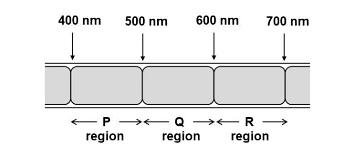How many ATP and NADPH2 are required for the synthesis of one molecule of Glucose during Calvin cycle?
How many ATP and NADPH2 are required for the synthesis of one molecule of Glucose during Calvin cycle?
18 ATP and 12 NADPH2
12 ATP and 16 NADPH2
18 ATP and 16 NADPH2
12 ATP and 12 NADPH2
The Correct Option is A
Solution and Explanation
The Calvin cycle, which is part of the light-independent reactions of photosynthesis, uses ATP and NADPH2 (reduced form of NADP+) generated during the light-dependent reactions to fix carbon dioxide and produce glucose. Specifically, it takes 18 molecules of ATP and 12 molecules of NADPH2 to synthesize one molecule of glucose.
Therefore, The correct option is (A): 18 ATP and 12 NADPH2
Top Questions on Photosynthesis in higher plants
- The net number of molecule(s) of NADH formed from one molecule of glucose in glycolysis under aerobic conditions is/are _______.
- IIT JAM BT - 2023
- Biology
- Photosynthesis in higher plants
- Which one of the following statements about photoproteins in plants is INCORRECT?
- IIT JAM BT - 2023
- Biology
- Photosynthesis in higher plants
- Different segments of a photosynthetic filamentous alga are exposed to different wavelengths of light as shown below. After a period of time, bacteria known to migrate towards high oxygen concentration, is spread on the surface of the alga. Which region(s) of the alga will have maximum bacterial congregation?

- IIT JAM BT - 2023
- Biology
- Photosynthesis in higher plants
The reaction centre PS II has an absorption maxima at
- NEET (UG) - 2023
- Biology
- Photosynthesis in higher plants
- Which one of the following is not true regarding the release of energy during ATP synthesis through chemiosmosis? It involves:
- NEET (UG) - 2022
- Biology
- Photosynthesis in higher plants
Questions Asked in NEET exam
- A thin flat circular disc of radius 4.5 cm is placed gently over the surface of water. If surface tension of water is 0.07 Nm-1, then the excess force required to take it away from the surface is :
- NEET (UG) - 2024
- Surface tension
- Which of the following are required for the dark reaction of photosynthesis?
A. Light
B. Chlorophyll
C. CO2
D. ATP
E. NADPH
Choose the correct answer from the options given below:- NEET (UG) - 2024
- Where Does Photosynthesis Take Place?
- If \(x=5\sin(\pi i+\frac{\pi}{3})m\) represents the motion of a particle executing simple harmonic motion, the amplitude and time period of motion, respectively, are :
- NEET (UG) - 2024
- simple harmonic motion
- The highest number of helium atoms is in
- NEET (UG) - 2024
- Electronic configuration of atoms and ions
- \(^{290}_{82}X\stackrel{\alpha}{\rightarrow}Y\stackrel{e^+}{\rightarrow}Z\stackrel{\beta^-}{\rightarrow}P\stackrel{e^-}{\rightarrow}Q\)
In the nuclear emission stated above, the mass number and atomic number of the product Q respectively, are :- NEET (UG) - 2024
- Nuclear physics
Concepts Used:
Photosynthesis in Higher Plants
Processes Of Photosynthesis in Higher Plants:
Photosynthesis in higher plants involves the following processes:
- Light Reaction
- Dark Reaction
Light Reaction:
- This phenomenon occurs in the presence of light.
- The pigment absorbs light and produces energy in the form of ATP.
- The process involves- absorption of light, water splitting, the release of oxygen, and formation of ATP and NADPH.
Dark Reaction:
This process occurs in the absence of light in the stroma of the chloroplasts. The following cycles are involved in the process:
- Calvin Cycle (C3 Cycle)
- C4 Cycle (Hatch and Slack Pathway)



